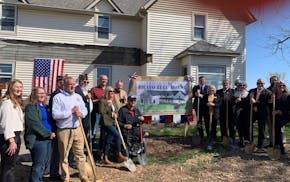WILLISTON, N.D. – The workers sometimes come in with stacks of $100 bills, their jeans and boots still covered in oil field mud as they scour the glass jewelry counter looking for clean sparkle.
One oil field worker plopped down $25,000 for a diamond for his girlfriend back home. Many others settle on $1,000 necklace pendants in the shape of a tiny oil derrick, a diamond anchoring the bottom where the oil would be.
"These guys spend lots of money on their women, and there's plenty of money to be spent," said Gina Abfalter, a clerk at Ritter Brothers Diamond Cutters downtown. "A lot of people just come in with thick wads of cash. The prosperity is amazing."
Call it cash on the oil barrelhead.
Sales have never been so good at this 40-year-old business in the heart of the oil boom. Or around the corner in the appliance store's TV department, where giant flat screens are a specialty. Or a few blocks away at a motor sports shop, where tricked out ATVs and motorcycles are sometimes hard to keep on the showroom floor.
While the oil boom may be overwhelming and taxing the patience of longtime locals, big-earning workers making extravagant purchases are also leaving piles of money and taxes in their wake.
Local businesses are capitalizing on the rush.
At Ritter Brothers, the front window features 24-karat gold-plated oil field mantelpiece sculptures, complete with moving pumpers. Well-lit jewelry cases show off men's rings with diamonds in the form of oil pumps and shiny $200 silver-and-brass belt buckles bragging: "Rockin' the Bakken."
"We really cater to the oil guys," said store owner Timothy Ritter, estimating that his business has probably doubled since the oil boom. "Everything sells pretty good in this environment."
Shiny new pickups
Indeed, the boom has brought the state giant sales tax gains in the west: In Williams County, where Williston sits, taxable sales and purchases have risen nearly eightfold since 2007, state records show. In McKenzie County, just to the south, it's gone up nearly sevenfold.
In Williston, a regional shopping hub, 1 percent of sales tax now brings in about $14 million, compared with less than $2 million in 2010.
Oil workers are also flooding local roads with new pickups; sales have at least tripled at the local Ford dealership, manager Kip Kolden said.
At Ekblad's appliance store downtown, oil field workers seek out giant flat-screen televisions in showrooms in the back. After spending long days on the job, many want to sit before a TV screen as big as possible in their often-cramped living quarters, one clerk said.
"A young person with money in their pockets, they're going to have no problem buying an 80- or 90-inch TV," store owner Jon Ekblad said.
Lake Sakakawea, Williston's closest body of water, is seeing more high-end boats and Jet Skis, too.
Sales have more than tripled at MonDak Motorsports, estimates sales manager Kyle Funge, who fondly recalled two oil field worker brothers coming in just to browse one day early this summer. One made a $30,000 impulse purchase: a utility all-terrain vehicle to ride around the vast countryside, complete with accessories.
"While we were waiting for one to trick his out, the other [brother] saw another one and fell in love," Funge said. That brother bought a $30,000 all-terrain vehicle on the spot, too.
"These guys are making more money than they've ever seen," he said. "They're able to buy all the toys that they've always dreamed about."
Even a gourmet kitchen store, Cooks on Main, is reaping benefits from oil field workers who like to cook or want high-quality caffeine. Wusthof knife sets ranging around $3,000 are hot sellers, as are espresso machines, owner Angela DeMars said.
$75 million rec center
The sales prosperity is spreading beyond business owners and benefiting the whole community; Williston's park district stopped collecting property tax and instead added a 1 percent sales tax in 2012, half of which is being used to pay for a huge new recreation center, which opened in March.
It holds traditional exercise machines, weights and basketball courts, but it also has racquetball courts, tennis courts, a baseball pitching machine, a golf simulator, birthday party rooms, a kitchen for cooking classes and a space for teens to hang out, away from adults. The centerpiece is a water park with an Olympic-sized pool, kiddie fountains, water slides and a Flow Rider surf machine.
Organizers are making memberships affordable, at $87 a month for a family of four.
Planners started with a concept that would have cost around $35 million, said Larry Grondahl, a former member of the park board. When officials asked citizens for ideas on what to include, the list kept growing.
"Sales tax revenues were going through the ceiling," he said. "We said, 'Why don't we deserve this? We've been going through a lot.' "
In the end, the project cost $75.2 million. The gleaming, glass-faced building is the nation's largest park district-owned rec center, at more than 236,000 square feet. It's luring families along with oil workers, which is the city's goal.
Bringing a family to the rec center "is like dropping your kids off at Disney," Grondahl said. "It's a game changer. … It's really changed people's outlook on moving here."
Pam Louwagie • 612-673-7102

Protesters briefly clash at dual pro-Israel, pro-Palestinian rallies at the University of Minnesota

Defense attorneys in Feeding Our Future trial cast doubt on FBI's meal fraud investigation

Overdose deaths spike after incarceration, but Minnesota jails lack treatment

